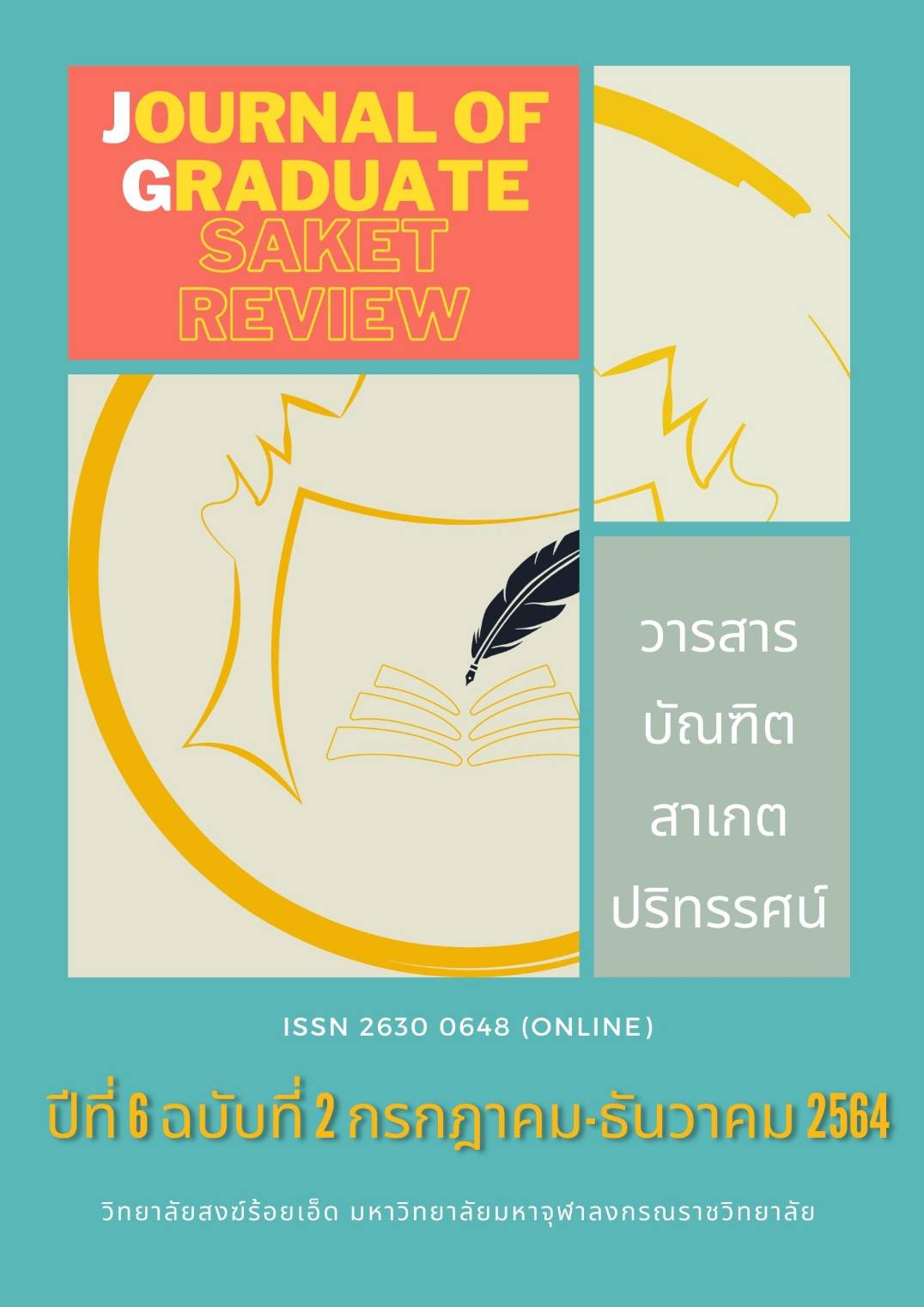"Amnat Phee Baramee Phut: Space of Religious Ideological Beliefs’ in Tri Aphirum’s romantic novel ‘Miti Thi Sarm"
Main Article Content
Abstract
The objective of the academic article was to study ‘Amnat Phee Baramee Phut: Space of Religious Ideological Beliefs’ in Tri Aphirum’s romantic novel ‘Miti Thi Sarm’ (Third Dimension),’ based upon the concept of ideology and Buddhism. The four important issues on the study consisted of 1) the role of a female leader as the victim, 2) Amnat Phee (spiritual power): the black magic and supermundane power, 3) Baramee Phut (the Buddha’s prestige): the sacred space and the Buddhist beliefs, and 4) the space of religious ideological beliefs. The study findings were as follows: 1) The role of a female leader as the victim reflected the consequence of prestige and merit, resulting from a lay woman’s observance of eight precepts on the Uposatha days and mental development, in order to counteract the sorcerers’ or black magicians’ superstition or black magic with the confidence of Buddhist teachings until she was blanketed in the consequence of merit/virtue. 2) Amnat Phee: Black Magic and Supermundane Power demonstrated beliefs in mysterious things, leading to various behaviours of a person and the society, which became the space for evil black magicians to make a black magic rite. 3) Baramee Phut: the sacred space and the Buddhist beliefs presented the miracle of mental development, based upon the view of the Buddhist forest monks purifying their minds by ‘insight development’ and ‘tranquillity development,’ to get free from dangers of evil magicians’ malevolence and black magic conjuration. 4) The space of religious ideological beliefs identified the author’s point of view. He believed in Thailand’s monarchy, so-called Divine Kingship or Deva Raja, in which the king was honorably praised as a person with supreme sacred and compassion due to Buddhism.
Article Details
เนื้อหาและข้อมูลในบทความที่ลงตีพิมพ์ในวารสารบัณฑิตสาเกตปริทรรศน์ ถือเป็นข้อคิดเห็นและความรับผิดชอบของผู้เขียนบทความโดยตรงซึ่งกองบรรณาธิการวารสาร ไม่จำเป็นต้องเห็นด้วย หรือร่วมรับผิดชอบใด ๆบทความ ข้อมูล เนื้อหา รูปภาพ ฯลฯ ที่ได้รับการตีพิมพ์ในวารสารบัณฑิตสาเกตปริทรรศน์ ถือเป็นลิขสิทธิ์ของวารสารบัณฑิตสาเกตปริทรรศน์ หากบุคคลหรือหน่วยงานใดต้องการนำทั้งหมดหรือส่วนหนึ่งส่วนใดไปเผยแพร่ต่อหรือเพื่อกระทำการใด ๆ จะต้องได้รับอนุญาตเป็นลายลักอักษรจากวารสารบัณฑิตสาเกตปริทรรศน์ ก่อนเท่านั้น
References
ประกอบสร้าง. วิทยานิพนธ์ศิลปศาสตรมหาบัณฑิต มหาวิทยาลัยมหาสารคาม.
ตรี อภิรุม. (2551). มิติที่สาม. (พิมพ์ครั้งที่2). นนทบุรี: อุทยานความรู้.
ธเนศ วงศ์ยานนาวา. (2556). เขียนหญิง : อำนาจ โยนี และการเขียนของลึงค์. กรุงเทพฯ: Unfinished Project
Publishing, สนพ.
ธีระพงษ์ มีไธสง. (2560). ผีกับพุทธการผสมผสานทางความเชื่อ. กรุงเทพ: อินทนิล.
บุญเหลือ โจมโน. (2556). ภาษาบาลีสันสกฤตในภาษาไทย. กรุงเทพฯ: แดเน็กซ์ อินเตอร์คอร์ปอเรชั่น.
ปริตตา เฉลิมเผ่า กออนันตกูล. (2546). เจ้าแม่ คุณปู่ ช่างซอ ช่างฟ้อน และเรื่องอื่น ๆ ว่าด้วย พิธีกรรมและ
นาฏกรรม. กรุงเทพ: ศูนย์มานุษยวิทยาสิรินธร.
วลีรัตน์ สิงหรา. (2528). เรื่องเหนือธรรมชาติในนวนิยายของจินตวีร์ วิวัธน์. มหาวิทยาลัยศรีนครินทรวิโรฒ
ประสานมิตร.
วินทร์ เลียววาริณ. (2560). 16 องศาเหนือ. กรุงเทพฯ: 113.
ศรีศักร วัลลิโภดม. (2562). พระพุทธศาสนาและความเชื่อของสังคมไทย (พิมพ์ครั้งที่3). กรุงเทพฯ: มูลนิธิเล็ก-
ประไพ วิริยะพันธ์.
สน สีมาตรัง. (2550). คติความเชื่อไตรภูมิและจักรวาลวิทยา ในจิตรกรรมฝาผนังไทย. กรุงเทพฯ: คณะมัณฑนศิลป์
มหาวิทยาลัยศิลปากร.
สายชล สัตยานุรักษ์. (2557). 10 ปัญญาชนสยาม เล่ม2. กรุงเทพฯ: Openbooks.
สายทิพย์ ภาณุทัต. (2555). ผีสางและเทวดา. กรุงเทพฯ: ฟอร์มิก.
อมรา พงศาพิชญ์. (2543). ความหลากหลายทางวัฒนธรรม (กระบวนทัศน์และบทบาทในประชาสังคม).
(พิมพ์ครั้งที่2). กรุงเทพฯ: จุฬาลงกรณ์มหาวิทยาลัย.

